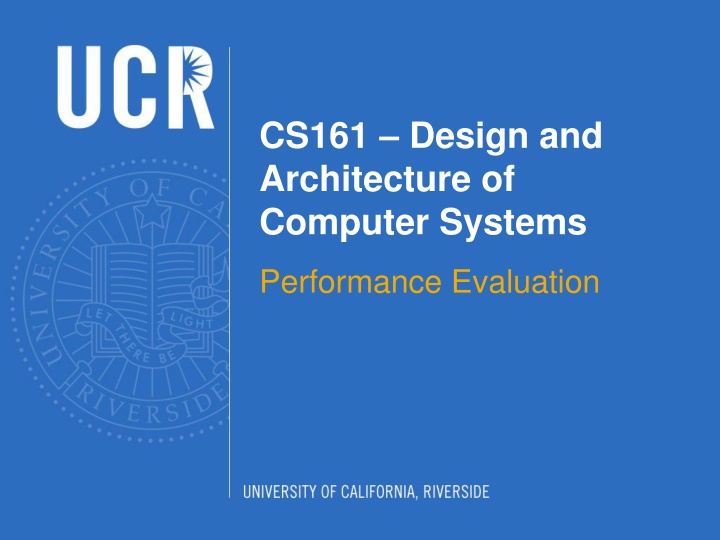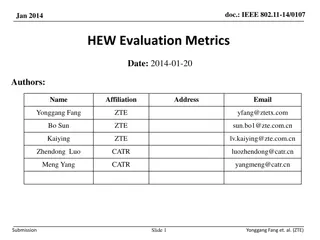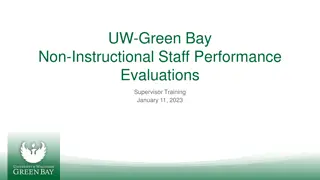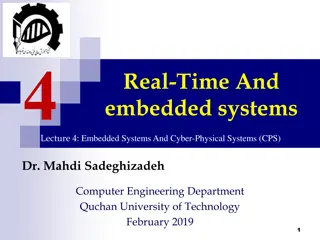Performance Evaluation in Computer Systems
In computer systems, performance evaluation is crucial in understanding response time, throughput, and relative performance. Measuring execution time, CPU clocking, and system performance are essential for optimizing system efficiency and identifying bottlenecks. This process involves analyzing factors like algorithm efficiency, processor speed, and I/O operations to enhance overall system performance.
Download Presentation

Please find below an Image/Link to download the presentation.
The content on the website is provided AS IS for your information and personal use only. It may not be sold, licensed, or shared on other websites without obtaining consent from the author.If you encounter any issues during the download, it is possible that the publisher has removed the file from their server.
You are allowed to download the files provided on this website for personal or commercial use, subject to the condition that they are used lawfully. All files are the property of their respective owners.
The content on the website is provided AS IS for your information and personal use only. It may not be sold, licensed, or shared on other websites without obtaining consent from the author.
E N D
Presentation Transcript
CS161 Design and Architecture of Computer Systems Performance Evaluation
Understanding Performance Algorithm Determines number of operations executed Programming language, compiler, architecture Determine number of machine instructions executed per operation Processor and memory system Determine how fast instructions are executed I/O system (including OS) Determines how fast I/O operations are executed
Response Time and Throughput Response time How long it takes to do a task Throughput Total work done per unit time e.g., tasks/transactions/ per hour How are response time and throughput affected by Replacing the processor with a faster version? Adding more processors? We ll focus on response time for now
Relative Performance Define Performance = 1/Execution Time X is n time faster than Y Performanc e Performanc e X Y = = Execution time Execution time n Y X Example: time taken to run a program 10s on A, 15s on B Execution TimeB / Execution TimeA = 15s / 10s = 1.5 So A is 1.5 times faster than B
Relative Performance Define Performance = 1/Execution Time X is n time faster than Y Performanc e Performanc e X Y = = Execution time Execution time n Y X Example: time taken to run a program 60s on A, 30s on B Execution TimeB / Execution TimeA= 30s / 60s = 0.5 So A is 0.5 times faster than B or B is 2 times faster than A
Measuring Execution Time Elapsed time Total response time, including all aspects Processing, I/O, OS overhead, idle time Determines system performance CPU time Time spent processing a given job Discounts I/O time, other jobs shares Comprises user CPU time and system CPU time Different programs are affected differently by CPU and system performance
CPU Clocking Operation of digital hardware governed by a constant-rate clock Clock period Clock (cycles) Data transfer and computation Update state Clock period: duration of a clock cycle e.g., 250ps = 0.25ns = 250 10 12s Clock frequency (rate): cycles per second e.g., 4.0GHz = 4000MHz = 4.0 109Hz
CPU Time = CPU Time CPU Clock Cycles Clock Cycle Time CPU Clock Cycles = Clock Rate Performance improved by Reducing number of clock cycles Increasing clock rate Hardware designer must often trade off clock rate against cycle count
CPU Time Example Computer A: 2GHz clock, 10s CPU time Designing Computer B Aim for 6s CPU time Can do faster clock, but causes 1.2 clock cycles How fast must Computer B clock be? Cycles Clock Rate Clock B = 1.2 Clock Cycles = B A CPU Time 6s B = Clock Cycles CPU Time Clock Rate A A A = = 9 10s 2GHz 20 10 9 9 1.2 20 10 24 10 = = = Clock Rate 4GHz B 6s 6s
Instruction Count and CPI = Clock Cycles Instructio Count n Cycles per Instructio n = CPU Time Instructio Count n CPI Clock Cycle Time Instructio Count n CPI = Clock Rate Instruction Count for a program Determined by program, ISA and compiler Average cycles per instruction Determined by CPU hardware If different instructions have different CPI Average CPI affected by instruction mix
CPI Example Computer A: Cycle Time = 250ps, CPI = 2.0 Computer B: Cycle Time = 500ps, CPI = 1.2 Same ISA Which is faster, and by how much? = CPU Time Instructio Count n CPI Cycle Time A A A = = I 2.0 250ps I 500ps A is faster = CPU Time Instructio Count n CPI Cycle Time B B B = = I 1.2 500ps I 600ps CPU Time I 600ps B = = 1.2 by this much CPU Time I 500ps A
CPI in More Detail If different instruction types take different numbers of cycles n = i = Clock Cycles (CPI Instructio Count n ) i i 1 Weighted average CPI Clock Cycles Instructio Count n n = i = = CPI CPI i i Instructio Count n Instructio Count n 1 Relative frequency
CPI Example Alternative compiled code sequences using instructions in type INT, FP, MEM Type CPI for type IC in Program 1 IC in Program 2 INT 1 2 4 FP 2 1 1 MEM 3 2 1 Program 1: IC = 5 Clock Cycles = 2 1 + 1 2 + 2 3 = 10 Avg. CPI = 10/5 = 2.0 Program 2: IC = 6 Clock Cycles = 4 1 + 1 2 + 1 3 = 9 Avg. CPI = 9/6 = 1.5
Performance Summary The BIG Picture The BIG Picture Instructio ns Clock cycles Seconds = CPU Time Program Instructio n Clock cycle Performance depends on Algorithm: affects IC, possibly CPI Programming language: affects IC, CPI Compiler: affects IC, CPI Instruction set architecture: affects IC, CPI, Tc
Power Trends In CMOS IC technology = 2 Power Capacitive load Voltage Frequency 30 1000 5V 1V
Reducing Power Suppose a new CPU has 85% of capacitive load of old CPU 15% voltage and 15% frequency reduction 2 P C 0.85 (V 0.85) 2 old F 0.85 = = = 4 0.85 0.52 new old old old P C V F old old old The power wall We can t reduce voltage further We can t remove more heat How else can we improve performance?
Multiprocessors Multicore microprocessors More than one processor per chip Requires explicitly parallel programming Compare with instruction level parallelism Hardware executes multiple instructions at once Hidden from the programmer Hard to do Programming for performance Load balancing Optimizing communication and synchronization
SPEC CPU Benchmark Programs used to measure performance Supposedly typical of actual workload Standard Performance Evaluation Corp (SPEC) Develops benchmarks for CPU, I/O, Web, SPEC CPU2006 Elapsed time to execute a selection of programs Negligible I/O, so focuses on CPU performance Normalize relative to reference machine Summarize as geometric mean of performance ratios CINT2006 (integer) and CFP2006 (floating-point) n = Execution time ratio n i i 1
CINT2006 for Opteron X4 2356 Name Description CPI Tc (ns) Exec time Ref time SPECratio IC 10 9 perl Interpreted string processing 2,118 0.75 0.40 637 9,777 15.3 bzip2 Block-sorting compression 2,389 0.85 0.40 817 9,650 11.8 gcc GNU C Compiler 1,050 1.72 0.47 24 8,050 11.1 mcf Combinatorial optimization 336 10.00 0.40 1,345 9,120 6.8 go Go game (AI) 1,658 1.09 0.40 721 10,490 14.6 hmmer Search gene sequence 2,783 0.80 0.40 890 9,330 10.5 sjeng Chess game (AI) 2,176 0.96 0.48 37 12,100 14.5 libquantum Quantum computer simulation 1,623 1.61 0.40 1,047 20,720 19.8 h264avc Video compression 3,102 0.80 0.40 993 22,130 22.3 omnetpp Discrete event simulation 587 2.94 0.40 690 6,250 9.1 astar Games/path finding 1,082 1.79 0.40 773 7,020 9.1 xalancbmk XML parsing 1,058 2.70 0.40 1,143 6,900 6.0 Geometric mean 11.7 High cache miss rates
SPEC Power Benchmark Power consumption of server at different workload levels Performance: ssj_ops/sec Power: Watts (Joules/sec) 10 10 = i = i = Overall ssj_ops per Watt ssj_ops power i i 0 0
SPECpower_ssj2008 for X4 Target Load % 100% 90% 80% 70% 60% 50% 40% 30% 20% 10% Performance (ssj_ops/sec) 231,867 211,282 185,803 163,427 140,160 118,324 920,35 70,500 47,126 23,066 Average Power (Watts) 295 286 275 265 256 246 233 222 206 180 141 2,605 493 0% 0 Overall sum 1,283,590 ssj_ops/ power
Fallacy: Low Power at Idle Look back at X4 power benchmark At 100% load: 295W At 50% load: 246W (83%) At 10% load: 180W (61%) Google data center Mostly operates at 10% 50% load At 100% load less than 1% of the time Consider designing processors to make power proportional to load
Pitfall: Amdahl s Law Improving an aspect of a computer and expecting a proportional improvement in overall performance T T = + unaffected T affected improved improvemen factor t Example: multiply accounts for 80s/100s How much improvement in multiply performance to get 5 overall? 80 n Can t be done! = + 20 20 Corollary: make the common case fast
Pitfall: MIPS as a Performance Metric MIPS: Millions of Instructions Per Second Doesn t account for Differences in ISAs between computers Differences in complexity between instructions Instructio count n = MIPS 6 Execution time 10 Instructio count n Clock rate = = Instructio count n CPI 6 CPI 10 6 10 Clock rate CPI varies between programs on a given CPU
Concluding Remarks Cost/performance is improving Due to underlying technology development Hierarchical layers of abstraction In both hardware and software Instruction set architecture The hardware/software interface Execution time: the best performance measure Power is a limiting factor Use parallelism to improve performance























